Become a big shot roulette player with our handy d’Alembert System Guide!
The d’Alembert System, the most famous roulette progression system, was born around the middle of 1700 and invented by one of the major mathematician and philosopher of the French Enlightenment. The d’Alembert is also known as “The Pyramid”, because of the shape of its fluctuating wagering structure.
General Concept
It was created for simple chances bets (Red/Black, Impair/Pair, Manque/Passe), where you alternate with two events but can be used on any even chance bet. The scope for this progression is to reach a balance between two chances. In other words, the system assumes eventually an equal amount of “Reds” and “Blacks”. Once you’ve reached the balance, you will register half unit winning for every bet (or one unit for every 2 bets).
Rule
It’s pretty easy: increase your bet one unit after every loss, and decrease one unit after every win.
Follow these simple points:
Fix the unit value (chip = £1, £5 or any other value)
Start the session by placing one unit on one of the even chance bets (e.g. “Black”)
After a losing bet you increase the next bet by one unit.
After a winning bet you decrease the next bet by one unit.
When you win by placing one unit, on the next spin you have to bet one unit again.
Stop bets when a balance between two chances is reached (equal number of “reds” and “blacks”).
Start a new betting session from point 1).
Practical examples
Let’s follow this first example:

– Spin #1: place 1 unit on Black, Red outcomes, you lose, the result of this spin is -1 unit, bankroll after the spin is -1 unit.
– Spin #2: increase your bet one unit: place 2 units on Black, Red outcomes again, you lose, the result of this spin is -2 units, bankroll after this spin is -3 units.
– Spin #3: increase your bet one unit: place 3 units on Black, Black outcomes, you win, result of this spin is +3 units, bankroll after this spin is 0.
– Spin #4: decrease your bet one unit: place 2 units on Black, Red outcomes, you lose, result of this spin is -2 units, bankroll after this spin is -2 units.
– Spin #5: increase your bet one unit: place 3 units on Black, Red outcomes, you lose, result of this spin is -3 units, bankroll after this spin is -5 units.
– Spin #6: increase your bet one unit: place 4 units on Black, Black outcomes, you win, result of this spin is +4 units, bankroll after this spin is -1 unit.
– Spin #7: decrease your bet one unit: place 3 units on Black, Black outcomes, you win, result of this spin is +3 units, bankroll after this spin is +2.
– Spin #8: decrease your bet one unit: place 2 units on Black, Black outcomes, you win, result of this spin is +2 units, bankroll after this spin is +4 units.
The two chances after 8 bets have reached the balance (4 “Reds” – 4 “Blacks”), the game on the Black has produced 4 winning pieces/units (8 spins divided by 2).
If we analyze three more hypothetical cases based on 12 bets, where the balance is reached, you can notice that the results are different. Why not try out our great selection of mobile roulette games today at Casino Football.
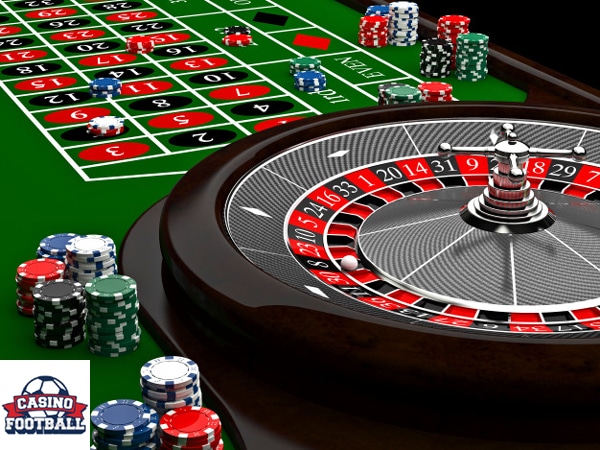
You can see the examples referred to combination RED/BLACK supposed betting always on RED.
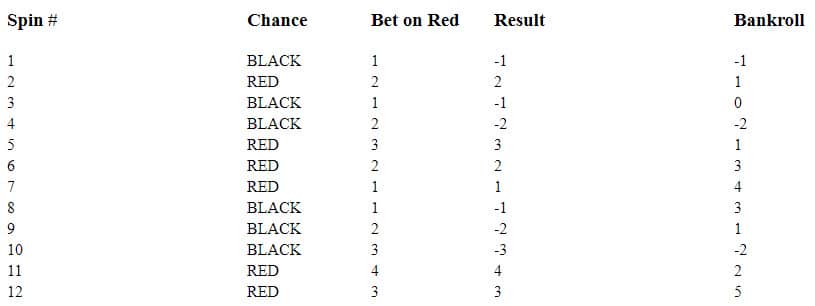
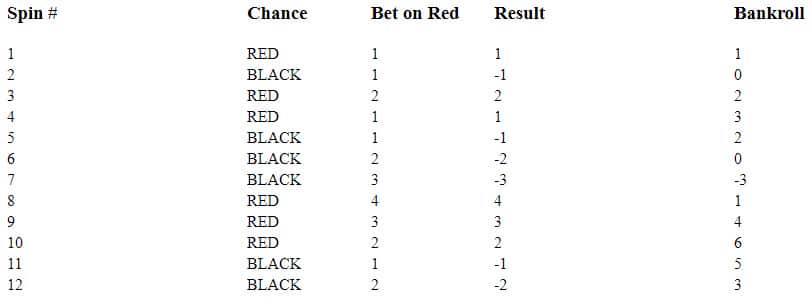
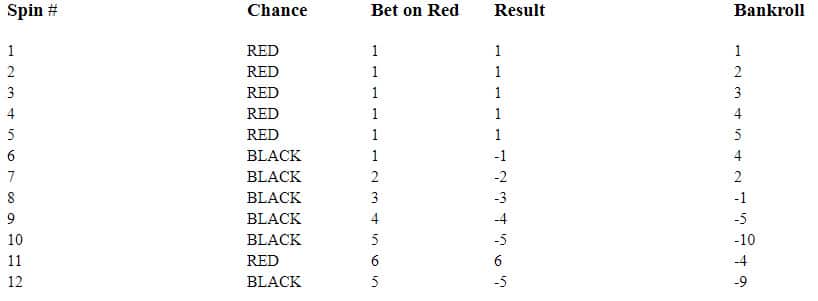
In all three examples presented there is a perfect balance as for the 12 spins taken into consideration you win 6 times. However while in the first two examples Red and Black are distributed mainly in a normal way and the final result is positive, in the third case we register a lost of nine units.
In order to close the game with a positive result you must search for the balance not when the game starts but when the negative series of Black begins. So in this case you would need extra spins to win the gaming session.
In these examples the figure 0 will not be taken into consideration. Normally, during low bet series, it will not affect the gaming session. But, if the zero outcomes during high bets, it will cause disastrous effects.
Roulette Guide Conclusions
The issue is the same as the other systems that are progressive : you will gain small value wins frequently, however your wins will most likely just cover your stakes, therefore also risk using your cash balance left.
The major negative aspect for the d’Alembert system is that you will win only if the balance is been achieved starting from a series of negative spins.
The d’Alembert system works correctly only when a balance has been reached between winning and losing bets.
The classic d’Alembert progression can be played with double chance (dozens and columns).
As the winning is for 2 pieces plus the bet, the game mechanism is the following: augment the bet with one unit after two bets lost and decrease by one unit after one winning bet.
There are numerous variations and many combinations but this one is for sure the most famous.
The Contra d’Alembert system
This system presents a variant in comparison with the classic d’Alembert system and therefore all previous considerations made are just the same. The Contra d’Alembert system has been projected when it was clear that the classic d’Alembert system required a great amount of money and the balance return would be delayed later with hundreds of spins.
General Concept
As the name implies, the Contra d’Alembert system is exactly the opposite of the classic d’Alembert system and it has been conceived to gain as much as possible during the positive series (which doesn’t occur in the classic d’Alembert). In this case, the main purpose is to obtain profit on reaching the balance between two chances.
Rule
It’s pretty easy again: Increase your bet by one unit after every win and decrease your bet by one unit after every loss.
- Fix the unit value (chip = £1, £5 or any other value)
- Start the session by placing one unit on one of the even chance bets (e.g. “Black”)
- After a losing bet you decrease the next bet by one unit
- After a winning bet you increase the next bet by one unit
- When you lose by placing one unit, on the next spin you have to bet one unit again
- Stop bets when a balance between two chances is reached (equal number of “reds” and “blacks”)
- Start a new betting session from point 1)
Practical examples

– Spin #1: place 1 unit on Black, Red outcomes, you lose, the result of this spin is -1 unit, bankroll after the spin is -1 unit.
– Spin #2: place 1 unit on Black again, Red outcomes again, you lose, the result of this spin is -1 unit, bankroll after this spin is -2 units.
– Spin #3: place 1 unit on Black again, Black outcomes, you win, result of this spin is +1 unit, bankroll after this spin is -1.
– Spin #4: increase your bet one unit: place 2 units on Black, Red outcomes, you lose, result of this spin is -2 units, bankroll after this spin is -3 units.
– Spin #5: decrease your bet one unit: place 1 unit on Black, Red outcomes, you lose, result of this spin is -1 unit, bankroll after this spin is -4 units.
– Spin #6: place 1 unit on Black again, Black outcomes, you win, result of this spin is +1 unit, bankroll after this spin is -3 unit.
– Spin #7: increase your bet one unit: place 2 units on Black, Black outcomes, you win, result of this spin is +2 units, bankroll after this spin is -1.
– Spin #8: increase your bet one unit: place 3 units on Black, Black outcomes, you win, result of this spin is +3 units, bankroll after this spin is 2 units.
The two chances after 8 bets have reached the balance (4 “Reds” – 4 “Blacks”), the game on the Black has produced 2 winning units.
Once again in this case, when reaching the balance (not considering the zero) it can produce a negative result, see the following example:

Conclusions
As this system offers reasonable protection of the downside, it’s one of the best to try (if you’re determined to play systems), because when losses come, your bets regress to the base level, where they will stay until the winnings return.
This means there are few large winnings and more smaller losses but also the winnings are likely to get fairly well wiped out with one loss after a group of winnings. It’s not bad to exploit a winning run, if it is used as a sporadic technique. There are other fantastic games available such as Pixies of the Forest, Siberian Storm Dual Play and many more to choose from at Casino Football. All of our games are compatible on all mobile phone types as well as Ipad Casino users and other tablet based players.
Reduced d’Alembert
A variation that permits to optimize the progressions. Remember the two principal faults present in the d’Alembert progression:
In certain balance stages, when the first bets are winning, on reaching the balance final result could be lost.
The balance could be reached before it’s useful.
General Concept
This version has been proposed to reduce the huge amount of money you normally risk in the classic d’Alembert system and permits to extend your gaming sessions in a more comfortable way.
This progression doesn’t aim to reach the balance but mainly to win a few quid.
Rule
Increase your bet by one unit for every five units loss and decrease by one unit for every five units recovered.
Restart a new gaming session every time that session is a positive bankroll even with only one unit.
Follow these simple points:
- Fix the unit value (chip = £1, £5 or any other value)
- Start the session by placing one unit on one of the even chance bets (e.g. “Red”)
- Increase the bet by one unit every time the bankroll is negative for 5 units
- Decrease the bet by 1 unit every time 5 units are recovered
- Every time the temporary bankroll is positive (accumulated result) even with only one unit, start a new betting session from point 1)
Practical examples
See this example:
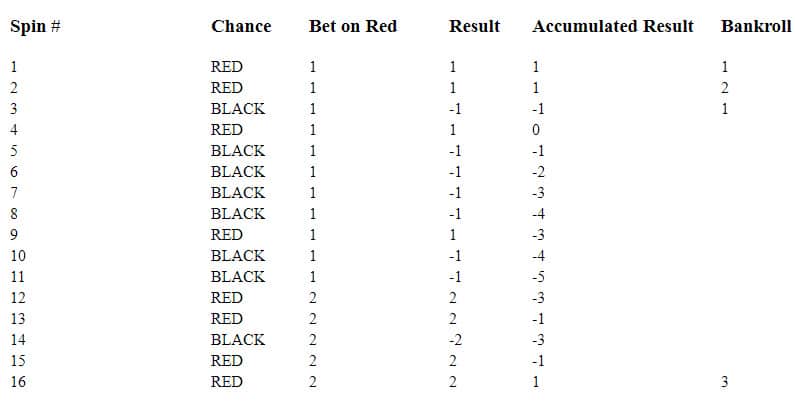
In the first two spins there are two gaming sessions both with one winning unit and therefore after two spins the bankroll is +2.
The third gaming session is longer, exactly 14 spins, before it can produce a positive accumulated result.
At the end of 16 spins the bankroll is +3 units.
Conclusions
As already stated, this system permits to drastically reduce the risks but rely on a minor profit and therefore you can play this system in a relaxed manner with a small amount of money.
